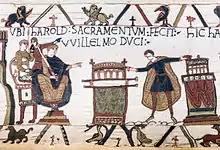Ecclesiastical fief
In the feudal system of the European Middle Ages, an ecclesiastical fief, held from the Catholic Church, followed all the laws laid down for temporal fiefs. The suzerain, e.g. bishop, abbot, or other possessor, granted an estate in perpetuity to a person, who thereby became his vassal.
| English feudalism |
|---|
 |
| Manorialism |
| Feudal land tenure in England |
| Feudal duties |
| Feudalism |
As such, the grantee at his enfeoffment did homage to his overlord, took an oath of fealty, and made offering of the prescribed money or other object, by reason of which he held his fief. These requirements had to be repeated as often as there was a change in the person of the suzerain or vassal. These fiefs were granted by churchmen to princes, barons, knights, and others, who thereupon assumed the obligation of protecting the church and domains of the overlord.
Features of the system
This system of feudal tenure was not always restricted to lands, as church revenues and tithes were often farmed out to secular persons as a species of ecclesiastical fief. Strictly speaking, however, a fief was usually defined as immovable property whose usufruct perpetually conceded to another under the obligation of fealty and personal homage. A fief was not ecclesiastical simply because its overlord was a churchman; it was requisite also that the domain granted should be church property. Lands, which belonged to the patrimony of an ecclesiastic, became a secular fief if he bestowed them on a vassal.
All fiefs were personal and hereditary, and many of the latter could be inherited by female descent.
Passive fiefs
Fiefs bestowed by the Church on vassals were called active fiefs; when churchmen themselves undertook obligations to a suzerain, the fiefs were called passive. In the latter case, temporal princes gave certain lands to the Church by enfeoffing a bishop or abbot, and the latter had then to do homage as pro-vassal and undertake all the implied obligations. When these included military service, the ecclesiastic was empowered to fulfil this duty by a substitute.
It was as passive fiefs that many bishoprics, abbacies, and prelacies, as to their temporalities, were held of kings in the medieval period, and the power thereby acquired by secular princes over elections to ecclesiastical dignities led to the strife over investitures. These passive fiefs were conferred by the suzerain investing the newly elected churchman with crozier and ring at the time of his making homage, but the employment of these symbols of spiritual power gradually paved the way to claims on the part of the secular overlords (see Investiture Conflict).
Papal fiefs
Papal fiefs included not only individual landed estates, however vast, but also duchies, principalities, and even kingdoms. When the pope enfeoffed a prince, the latter did homage to him as to his liege lord, and acknowledged his vassalage by an annual tribute. Pope Pius V (29 March 1567) decreed that, in future, fiefs belonging strictly to the Patrimony of St. Peter should be incorporated with the Pontifical States whenever the vassalage lapsed, and that no new enfeoffment take place.
King John of England declared that he held his realm as a fief from the pope in 1213, and King James II of Aragon accepted the same relation for Sardinia and Corsica in 1295.
The most famous papal fief, the Kingdom of Naples and Sicily, sprang from investitures of 1059 and 1269. Compare Terra Mariana, the lands in Livonia considered directly subject to the Holy See from 1215.[1]
The Lordship of Ireland was for centuries considered a papal fief of the King of England, granted to Henry II of England by Pope Adrian IV by the 1155 bull Laudabiliter.[2][3]
References
-
Compare:
Bojtár, Endre (1997). "5.4: The conquest of Livonia". Foreword to the Past: A Cultural History of the Baltic People. Historia könyvtar. 4. Translated by Rédey, Szilvia. Budapest: Central European University Press (published 1999). p. 124. ISBN 9789639116429. Retrieved 2017-07-12.
The concept of Livonia expanded with the conquest. It was also referred to as Maria's land after 1202 when the Pope took it under his auspices (Terra Mariana, Terra Matris, Terra beate Virginis), initially referring to the triangle of the lower sections of the Daugava and the Gauja, which roughly corresponds to today's Vidzeme. [...] Considering the land as his own allodium (fief) in 1207 Bishop Albert offered the land to the German King Philip who immediately returned it to the bishop as a feudum oblatum (fiefdom). [...] Establishing a Church state was always the underlying agenda of the crusades (Taube 1938, 21).
- Duffy, Seán (15 January 2005). Medieval Ireland: An Encyclopedia. Routledge. ISBN 9781135948245 – via Google Books.
- J, Dr Thomas M. McCoog S. (28 July 2013). The Society of Jesus in Ireland, Scotland, and England, 1589–1597: Building the Faith of Saint Peter upon the King of Spain's Monarchy. Ashgate Publishing, Ltd. ISBN 9781409482826 – via Google Books.
- Attribution
 This article incorporates text from a publication now in the public domain: Herbermann, Charles, ed. (1913). "Ecclesiastical Tenure". Catholic Encyclopedia. New York: Robert Appleton Company.
This article incorporates text from a publication now in the public domain: Herbermann, Charles, ed. (1913). "Ecclesiastical Tenure". Catholic Encyclopedia. New York: Robert Appleton Company.